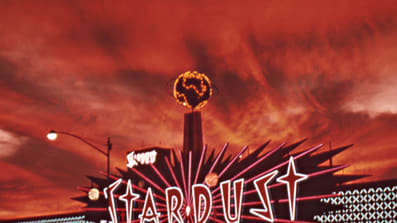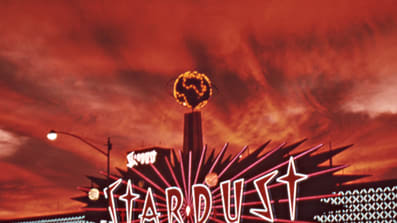A new exhibition at MOCA LA highlights the landmark photography study of Sin City in the ’60s by architects Robert Venturi and Denise Scott Brown. VIEW OUR GALLERY.
Vast parking lots speckled with classic cars; blue skies and expanses of desert punctuated with block lettering (BUS, MOTEL, TEXACO, STARDUST); squat buildings sheathed by enormous placards; marquees promoting names like Jack Benny, Bobby Darin, and Eartha Kitt; acid-trip-worthy neon signage; billboards dripping with languid showgirls. It’s the Las Vegas of Sinatra, Elvis, Mo Green, crazy Howard Hughes, even Hunter S. Thompson—and a city that’s been dead for some time now. (Literally. Go see the wreckage yourself.)
In retrospect, it all seems very quaint and colorful. But a new exhibition at the Museum of Contemporary Art Pacific Design Center in Los Angeles reminds us that this dearly departed incarnation of Sin City had more to offer than just bright lights, dapper crooners, and Mafia goodfellas.
Click Image To View Our Gallery Of Vintage Las Vegas

Indeed, Robert Venturi, Denise Scott Brown, and Steven Izenour’s Learning from Las Vegas, first published by MIT Press in 1972, is still arguably the most significant treatise on form and function written in the last 50 years. Now, the films and photographs that inspired the study are getting some long-deserved attention themselves.
Married architects Venturi and Scott Brown, and their fleet of 13 Yale grad students, shot 5,000 color slides and 3,000 meters of film during a 10-day Strip excursion in 1968, capturing every angle of this still-novel desert wonder. Swiss curators and art historians Martino Stierli and Hilar Stadlar (in collaboration with artist Peter Fischli of the irreverent duo Fischli/Weiss) whittled that selection down to some 80 photographs and several short films for an exhibition that originated at the Museum im Bellpark in Kriens, Switzerland, and will be on view at MOCA through June 20.
Taking a cue from Pop artists such as Ed Ruscha and Andy Warhol, Venturi and Scott Brown set out to prove that mass culture wasn’t intellectually off-limits for architects either. Billboards, they argued, were part of the spatial experience itself, as were those neon lights, boxy buildings, and sign-studded highways. They called it an “architecture of communication” and of vast symbolism on a par with the structures of Medieval and Renaissance Europe; they likened the Vegas Strip to the Piazza Navona in Rome, and the city’s commandeering of vast spaces to that of Versailles.
As you might expect, this lofty view of the city was somewhat controversial at the time.
“Las Vegas was so astounding—you hated it and you loved it,” says Scott Brown, 78, speaking by phone from the Philadelphia home she shares with Venturi. “It began to tell us about symbolism in cities. The Modernists said, ‘We’re against symbols,’ but, in fact, they weren’t. They used the symbols of industry.”
Scott Brown adds that the politics she and Venturi shared were points of contention as well. “We were looking at diversity, pop culture, industry, and the end of innocence,” she says. “People didn’t like that we were very much involved with civil rights. They didn’t like the idea that mass production’s first real use was in the Holocaust—the industrialization of death. We were saying all those things, and that popular culture needs to be taken seriously.”
But for architecture students, the Las Vegas study was revolutionary: They started taking stock of the social and structural phenomena around them (they started taking pictures, too—a means of studying space that more or less originated with Venturi and Scott Brown’s landmark study).
“It’s still incredibly relevant,” says Robert A.M. Stern, dean of the Yale School of Architecture. “Architects need to learn from what is out there in the world. And today, when the computer so circumscribes the means for architects to pursue their ideas, it’s essential that they get out from behind their screens and see how real people operate in the built world.”
Venturi and Scott Brown revisited Las Vegas in 1997 and again last year. And they didn’t love what they saw. Scott Brown notes a distinct de-neon-ification, spearheaded by the city’s new unofficial czar, hotelier Steve Wynn. Bright signage has given way to the buildings themselves (Epcot-esque miniature cities and soaring glass towers, for the most part). What was once right out there on the Strip has receded a bit—hotels now look to instill a sense of exclusive luxury, no more of this Day-Glo-hued “come one, come all” attitude.
Stern, for one, would love to see the duo tackle the city again. “Vegas is like the [nine] layers of Troy,” he says. “And I think we’re only on number three.”
Plus: Check out Art Beast, for galleries, interviews with artists, and photos from the hottest parties.
Rachel Wolff is a New York-based writer and editor who has covered art for New York, ARTnews, and Manhattan.

